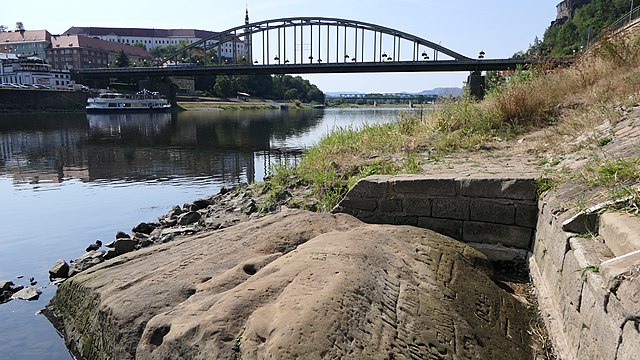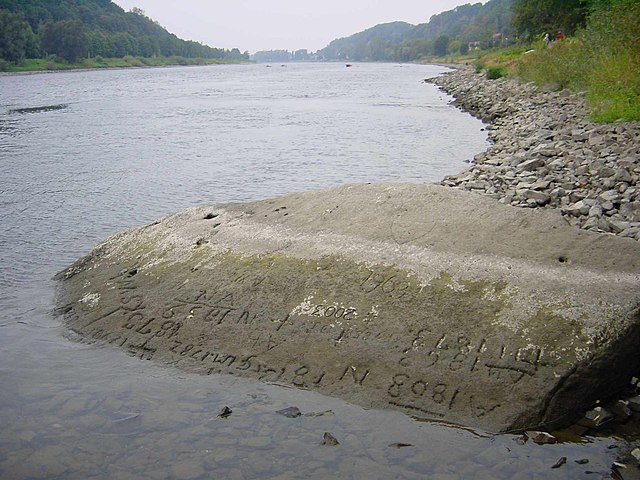The Hunger Stones
The Elbe River is one of Eastern Europe’s major waterways, running through the modern-day Czech Republic and into parts of Germany. The nearly-700 mile (1,112 km) long waterway, historically, was the lifeblood of civilization in the area; if you, were, say, a farmer from 200 years ago, the Elbe provided the water for your crops and livestock. And if the Elbe ran low, that was bad news — dead crops, meager animals, and ultimately, famine. So, what do you do?
Well, starve, unfortunately. There’s not much you can do if the river runs dry. But if you had some prior warning, perhaps you could prepare for the future — save some of your food and store it for a literally less-rainy day. Which is where the below comes in.

No, not the bridge. The stone. The big one, at the bottom, with the etchings on it. That one is near the Czech city of Děčín, but there are more — perhaps as many as two dozen. Here’s another, with clearer etchings, near Prina, Germany, about an hour’s drive up the river.

The stone carvings, basically, share one very clear message: if you can see this, life is about to get tough. During times of drought, the Elbe’s water level drops, exposing some of the rocks otherwise well underwater. To give future generations a heads-up of the tough times to come, the people then-suffering carved messages in the rocks — messages that would only appear if the water level receded again.
And unfortunately, that happened more often than we’d like. Often, the engravings included the year the message was written; as a result, we know that on average, at least one of the reminders appear every ten years or so. Most recently, in 2018, the Czech Republic was struck by an unusually dry summer. Out came many of the stones, the oldest visible one dating back four centuries, to the year 1616. And the message on that rock wasn’t a cheery one; as the Associated Press reported, the stone “bears a chiseled inscription in German that says: ‘When you see me, cry.'” Other stones in the region have similar messages. Per Smithsonian, “one of the rocks, for instance, ‘expressed that drought had brought a bad harvest, lack of food, high prices and hunger for poor people.'” Another one, pictured here (in Germany’s Weser River), takes an even more direct route: it reads “Hungerstein,” which translates to “hunger stone.”
But not everyone is so concerned with the so-called hunger stones. Per Reuters, “as time went by, the doom and gloom gave way to a more humorous and entrepreneurial approach.” For example, a message written in 1904 “was answered in a poem in the 1930s by the owner of a local pump factory with: ‘Don’t cry, girl, don’t fret. When it’s dry, just spray your field wet,'” says Reuters. And today, modern infrastructure means less threat of famine, even during unusually hot summers. As NPR calmly reassures us, when the stones appeared in 2018, they became more of a tourist trap than a harbinger of doom.
Bonus fact: The dry summer of 2018 revealed another thing in the Elbe River — bombs. During World War II, the river banks were the scene of a lot of fighting, and a lot of ammunition — hand grenades, in particular — ended up in the water. And a lot of those bombs never went off. According to German website DW, while unlikely, that can be a problem: “After more than 70 years embedded in the riverbanks or riverbed, the bombs tend to have corroded and been covered with a thick crust of sediment. That makes it unlikely they will simply explode. Even so, police have appealed to people not to touch the explosives but rather to notify them immediately.”
From the Archives: A Concrete Solution: Another way to use the landscape — okay, and a cement mixer in this case — to send a message.
